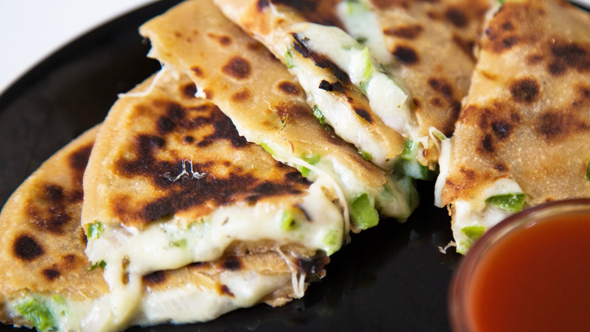Mama’s Punjabi Recipes: Cheese da Parantha (Grated Cheese Parantha)
When mama’s great-grandkids visited her and asked for them, it was clear how delicious the Cheese Parantha can be! So here is a reprint of Mama’s Cheese da Parantha recipe which are surely a favorite of kids and grown-ups alike. It is reprinted with some additional information and directions.
Plain Punjabi paranthas (crispy flat bread) are popular for their crispiness, buttery taste and huge, filling size and now are readily available the world over at restaurants and in the frozen food sections of many desi stores and even regular supermarkets.
For the younger generation paranthas have taken on a new identity in a variation called the parantha roll which is nothing more than some filling rolled up in a plain parantha. So it’s like having the stuffing outside the bread rather than inside! It’s similar to having a stuffed burrito or a gyro sandwich, but of course, the main item is the bread or parantha, which cannot be duplicated.
In the late 1950’s when we lived in London, my kids came up with the idea of stuffing the parantha with grated Cheddar cheese – and they loved to eat them hot off the tava (flatplate). They loved the tastiness of the melted cheese and this was before they knew about pizzas! Since then, they were little, my grandkids – and now in 2018, my great-grandkids – love these cheese paranthas and always clamor for more!
Cheese paranthas are actually better than cheese pizza because the dough is completely cooked on both sides, rather than staying soggy and wet as pizza dough can get. In fact, some restaurants actually make thin crust pizzas from wheat dough and then sprinkle ingredients on top like tandoori chicken, eggplants and onions, calling them “tandoori pizza” or some other Indian name.
There are many types of stuffed paranthas: aloo (potatoes), gajjar (carrots), phul gobi (cauliflower), mouli (white radish) or piyaaz (onions), and you can make many more with other ingredients like daal (lentils) or bhindi (okra) or baingan (eggplant). But many young kids in the West only go for items they recognize, so aloo is the most popular. To this, you should add cheese and see how your young children react. The secret to a good, crispy parantha is to make sure that the atta (dough) does not get too soft with the stuffing. Cheese paranthas generally do not use any spices; and there is no need to add salt as the cheese is salty enough by itself.
Most paranthas can be eaten with a dollop of butter placed on top, plain yogurt alone or with achaar (pickles). But hot cheese paranthas taste much better alone, just like a cheese pizza!
Ingredients:
• 500gm kanak (gehon) ka atta (wheat flour)
• 100 gm grated cheddar (or any cheese of your choice)
• 2 tbsp tael (olive oil or vegetable oil)
• 1 1/2 cups pani (water)
• Spices to taste: mirch (red pepper)
Directions:
1. Cut open the packet of grated cheese and if you prefer, add the red pepper, mix well and keep to the side in a bowl.
2. Pour the flour in a bowl and slowly pour in water while kneading the dough till it becomes a nice, tender by firm ball. Dab the surface of the ball with a little water to keep it moist, cover the bowl and set aside. The dough should be soft but not watery, if the dough is too hard, the parantha will also be hard.
3. If you want to cook later, dab the top of the atta with a small amount of oil to see the crust soft and then leave the dough in the refrigerator for 30 minutes. You should not cook the paranthas right after making the dough as they will come out hard.
4. Break the dough into small paade (balls) and then roll out into an 8 to 10 inch circle. Now place a small amount of the grated cheese into the middle of the circle so that it can be closed easily and does not tear when rolled out again. It should roll out easily.
5. Put a small dab of oil on a hot tava (hotplate or skillet) and place the flattened dough on. When it turns color a little, turn the parantha over. Put another dab of oil on the tava and then turn it over again till it is fully cooked. The parantha will be cooked when it has some dark brown spots on it.
6. Serve hot as the cheese will still be soft. If you want more taste, you can try these with some sabzi (vegetables) or daal (lentils).
MAMA’S TIP OF THE WEEK: CAREFUL HOW YOU KEEP VEGETABLES IN THE FRIDGE
Many people go grocery shopping and when they get back home will place the vegetables or fruits in the refrigerator, sometimes carelessly placing them on the glass shelf instead of inside the crisper bin. A couple of days later, they will find that the side on which the vegetable was lying has become dented, soft and the inside is frozen. Usually this vegetable cannot be cooked and has to be thrown away.
Always place the vegetables and fruit inside the crisper bin. If there is no space, place them on a piece of cloth to avoid touching the surface to the cold shelf. Frozen vegetables do not cook well and often become tough to eat.

Shakuntla Malhotra is a skilled cook of Punjabi dishes made in the old-fashioned style that she learnt as a young woman in her ancestral home in Lyallpur, India (since renamed Faisalabad) before it became part of Pakistan after the Partition in 1947. People have often admired her cooking for its simplicity and taste that comes with each mouthful. Even in her late-eighties, she continues to cook daily and agreed to share her delectable Punjabi recipes for future generations.

